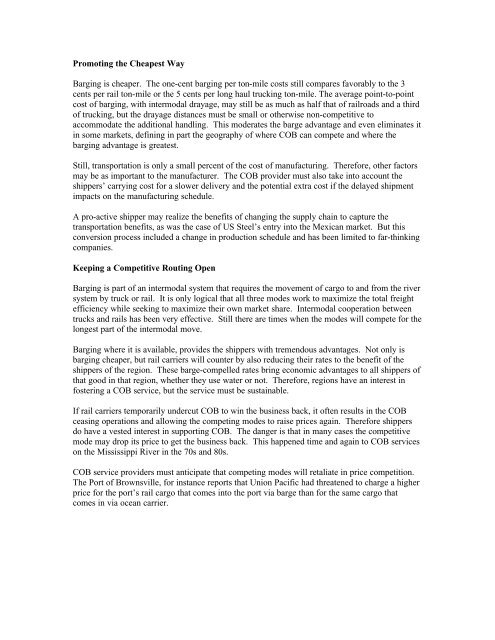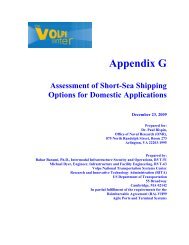Container-on-Barge Pre-Feasibility Study Final Report - Towmasters ...
Container-on-Barge Pre-Feasibility Study Final Report - Towmasters ...
Container-on-Barge Pre-Feasibility Study Final Report - Towmasters ...
Create successful ePaper yourself
Turn your PDF publications into a flip-book with our unique Google optimized e-Paper software.
Promoting the Cheapest Way<br />
Barging is cheaper. The <strong>on</strong>e-cent barging per t<strong>on</strong>-mile costs still compares favorably to the 3<br />
cents per rail t<strong>on</strong>-mile or the 5 cents per l<strong>on</strong>g haul trucking t<strong>on</strong>-mile. The average point-to-point<br />
cost of barging, with intermodal drayage, may still be as much as half that of railroads and a third<br />
of trucking, but the drayage distances must be small or otherwise n<strong>on</strong>-competitive to<br />
accommodate the additi<strong>on</strong>al handling. This moderates the barge advantage and even eliminates it<br />
in some markets, defining in part the geography of where COB can compete and where the<br />
barging advantage is greatest.<br />
Still, transportati<strong>on</strong> is <strong>on</strong>ly a small percent of the cost of manufacturing. Therefore, other factors<br />
may be as important to the manufacturer. The COB provider must also take into account the<br />
shippers’ carrying cost for a slower delivery and the potential extra cost if the delayed shipment<br />
impacts <strong>on</strong> the manufacturing schedule.<br />
A pro-active shipper may realize the benefits of changing the supply chain to capture the<br />
transportati<strong>on</strong> benefits, as was the case of US Steel’s entry into the Mexican market. But this<br />
c<strong>on</strong>versi<strong>on</strong> process included a change in producti<strong>on</strong> schedule and has been limited to far-thinking<br />
companies.<br />
Keeping a Competitive Routing Open<br />
Barging is part of an intermodal system that requires the movement of cargo to and from the river<br />
system by truck or rail. It is <strong>on</strong>ly logical that all three modes work to maximize the total freight<br />
efficiency while seeking to maximize their own market share. Intermodal cooperati<strong>on</strong> between<br />
trucks and rails has been very effective. Still there are times when the modes will compete for the<br />
l<strong>on</strong>gest part of the intermodal move.<br />
Barging where it is available, provides the shippers with tremendous advantages. Not <strong>on</strong>ly is<br />
barging cheaper, but rail carriers will counter by also reducing their rates to the benefit of the<br />
shippers of the regi<strong>on</strong>. These barge-compelled rates bring ec<strong>on</strong>omic advantages to all shippers of<br />
that good in that regi<strong>on</strong>, whether they use water or not. Therefore, regi<strong>on</strong>s have an interest in<br />
fostering a COB service, but the service must be sustainable.<br />
If rail carriers temporarily undercut COB to win the business back, it often results in the COB<br />
ceasing operati<strong>on</strong>s and allowing the competing modes to raise prices again. Therefore shippers<br />
do have a vested interest in supporting COB. The danger is that in many cases the competitive<br />
mode may drop its price to get the business back. This happened time and again to COB services<br />
<strong>on</strong> the Mississippi River in the 70s and 80s.<br />
COB service providers must anticipate that competing modes will retaliate in price competiti<strong>on</strong>.<br />
The Port of Brownsville, for instance reports that Uni<strong>on</strong> Pacific had threatened to charge a higher<br />
price for the port’s rail cargo that comes into the port via barge than for the same cargo that<br />
comes in via ocean carrier.
















